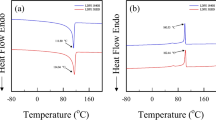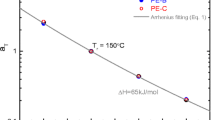Abstract
Processing at the highest possible throughput rates is essential from an economical point of view. However, various flow instabilities and extrudate distortions like sharkskin, stick slip, and gross melt fracture (GMF) may limit the production rate of high-quality products. Predicting the process conditions leading to the occurrence of rheological instabilities is the key for improving product quality, process control, and optimization. Large-amplitude oscillatory shear (LAOS) and FT-rheology were used to quantify the non-linear rheological behavior and instabilities of a series of well-characterized commercial polyethylene (PE). From the latter, we derive the critical non-linearity parameter, F 0,c, which corresponds to the normalized intensity of the third harmonic at the critical strain amplitude, γ 0,C (defined by the appearance of the second harmonic), normalized by γ 0,C . The F 0,c is correlated with the high molecular mass fraction of the polymers and with the Deborah numbers. Linear rheological parameters and molecular structures were related to F 0,c. An experimental correlation between F 0,c of commercial PE melts and pressure fluctuations associated with flow instabilities (sharkskin) was established both for capillary rheometry and extrusion.












Similar content being viewed by others
References
Ansari M, Hatzikiriakos SG, Sukhadia AM, Rohlfing DC (2011) Rheology of ZN and metallocene HDPE: broad molecular weight distribution effects. Rheol Acta 50:17–27
Ansari M, Inn YW, Sukhadia AM, DeLauriers PJ, Hatzikiriakos SG (2013a) Melt fracture of HDPEs: metallocene versus Ziegler–Natta and broad MWD effects. Rheol Acta 53:4195–4201
Ansari M, Inn YW, Sukhadia AM, DeLauriers PJ, Hatzikiriakos SG (2013b) Wall slip of HDPEs: molecular weight and molecular weight distribution. J Rheol 57:927–948
Ansari M, Inn YW, Sukhadia AM, DesLauriers PJ, Hatzikiriakos SG (2012) Melt fracture of HDPEs: metallocene versus Ziegler–Natta and broad MWD effects. Polymer 53:4195–4201
Baumgaertel M, Winter HH (1989) Determination of discrete relaxation and retardation time spectra from dynamic mechanical data. Rheol Acta 28:511–519
Chen YL, Larson RG, Patel SS (1994) Shear fracture of polystyrene melts and solutions. Rheol Acta 33:243–256
Cogswell FN (1977) Stretching flow instabilities at the exits of extrusion dies. J Non-Newton Fluid 2:37–47
Denn MM (2001) Extrusion instabilities and wall slip. Annu Rev Fluid Mech 33:265–287
Ewoldt RH, Hosoi AE, McKinley GH (2008) New measures for characterizing nonlinear viscoelasticity in large amplitude oscillatory shear. J Rheol 52:1427–1458
Fahimi Z, Broedersz CP, van Kempen THS, Florea D, Peters GWM, Wyss HM (2014) A new approach for calculating the true stress response from large amplitude oscillatory shear (LAOS) measurements using parallel plates. Rheol Acta 53:75–83
Filipe S, Vittorias I, Wilhelm M (2008) Experimental correlation between mechanical non-linearity in LAOS flow and capillary flow instabilities for linear and branched commercial polyethylenes. Macromol Mater Eng 293:57–65
Graham MD (1995) Wall slip and the nonlinear dynamics of large amplitude oscillatory shear flows. J Rheol 39:697–712
Hatzikiriakos SG (2012) Wall slip of molten polymers. Prog Polym Sci 37:624–643
Hatzikiriakos SG, Dealy JM (1991) Wall slip of molten high density polyethylene. I. Sliding plate rheometer studies. J Rheol 35:497–523
Hatzikiriakos SG, Dealy JM (1992) Role of slip and fracture in the oscillating flow of HDPE in a capillary. J Rheol 36:845–884
Henson DJ, Mackay ME (1995) Effect of gap on the viscosity of monodisperse polystyrene melts: slip effects. J Rheol 39:359–373
Hyun K, Wilhelm M (2009) Establishing a new mechanical nonlinear coefficient Q from FT-rheology: first investigation of entangled linear and comb polymer model systems. Macromolecules 42:411–422
Hyun K, Wilhelm M, Klein CO, Choc KS, Nam JG, Ahn KH, Leed SJ, Ewoldt RH, McKinley GH (2011) A review of nonlinear oscillatory shear tests: analysis and application of large amplitude oscillatory shear (LAOS). Prog Polym Sci 36:1697–1753
Ilyin SO, Malkin AY, Kulichikhin VG (2014) Application of large amplitude oscillatory shear for the analysis of polymer material properties in the nonlinear mechanical behavior. Polym Sci 56:98–110
Inn YW (2013) Melt fracture and wall slip of metallocene-catalyzed bimodal polyethylenes in capillary flow. J Rheol 57:393–406
Larson RG (1992) Instabilities in viscoelastic flows. Rheol Acta 31:213–263
Morrison FA (2001) Understanding rheology. Oxford University Press, New York
Münstedt H, Schmidt M, Wassner E (2000) Stick and slip phenomena during extrusion of polyethylene melts as investigated by laser-Doppler velocimetry. J Rheol 44:413–428
Reimers MJ, Dealy JM (1998) Sliding plate rheometer studies of concentrated polystyrene solutions: nonlinear viscoelasticity and wall slip of two high molecular weight polymers in tricresyl phosphate. J Rheol 42:527–548
Stickel JJ, Knutsen JS, Liberatore MW (2013) Response of elastoviscoplastic materials to large amplitude oscillatory shear flow in the parallel-plate and cylindrical-Couette geometries. J Rheol 57:1569–1596
Trinkle S, Friedrich C (2001) Van Gurp-Palmen-plot: a way to characterize polydispersity of linear polymers. Rheol Acta 40:322–328
Vittorias I (2006) Fourier-transform rheology applied on homopolymer melts of different architectures—experiments and finite element simulations. Dissertation, Technical University Darmstadt
Vittorias I, Lilge D, Baroso V, Wilhelm M (2011) Linear and non-linear rheology of linear polydisperse polyethylene. Rheol Acta 50:691–700
Wang SQ (1999) Molecular transitions and dynamics at polymer/wall interfaces: origins of flow instabilities and wall slip. Adv Polym Sci 138:227–275
Wang SQ, Drda P, Inn YW (1996) Exploring molecular origins of sharkskin, partial slip, and slope change in flow curves of linear low density polyethylene. J Rheol 40:875–898
Wilhelm M (2002) Fourier-transform rheology. Macromol Mater Eng 287:83–105
Winter HH, Moors M (2005) IRIS handbook. IRIS Development, Amherst
Yu W, Du Y, Zhou C (2013) A geometric average interpretation on the nonlinear oscillatory. J Rheol 57:1147–1175
Acknowledgments
This work was supported by the Portuguese Foundation for Science and Technology through the Strategic Project PEst-C/CTM/LA0025/2011 (Strategic Project-LA 25-2011-2012). The authors thank also the European Union and EACEA for granting project 2008-0099-EURHEO: The Erasmus Mundus Master in Engineering Rheology. The authors would like also to thank Dr. Dieter Lilge for the molecular characterization and Johannes Müller for the samples and the valuable input.
Author information
Authors and Affiliations
Corresponding author
Rights and permissions
About this article
Cite this article
Cyriac, F., Covas, J.A., Hilliou, L.H.G. et al. Predicting extrusion instabilities of commercial polyethylene from non-linear rheology measurements. Rheol Acta 53, 817–829 (2014). https://doi.org/10.1007/s00397-014-0798-7
Received:
Revised:
Accepted:
Published:
Issue Date:
DOI: https://doi.org/10.1007/s00397-014-0798-7




